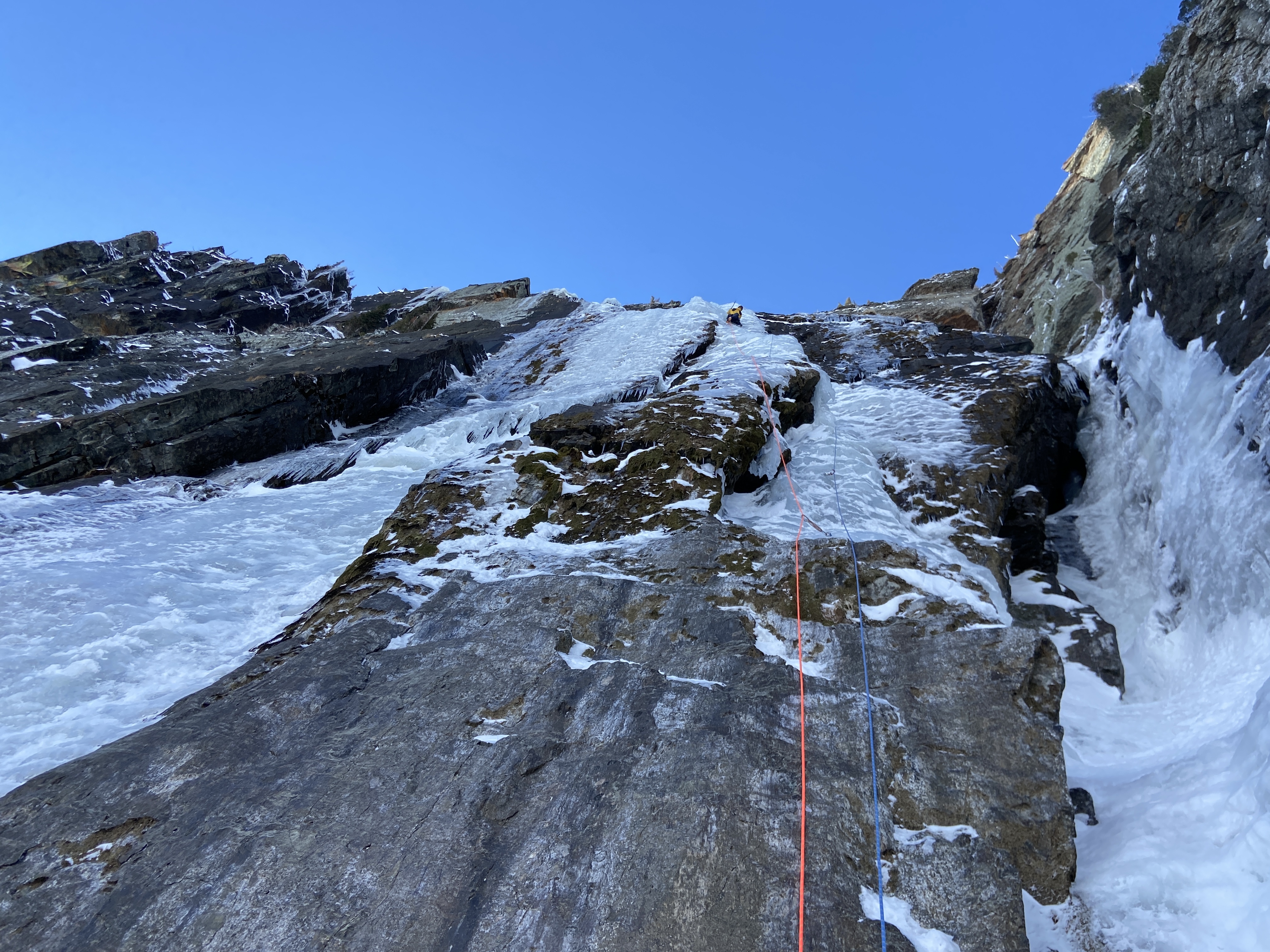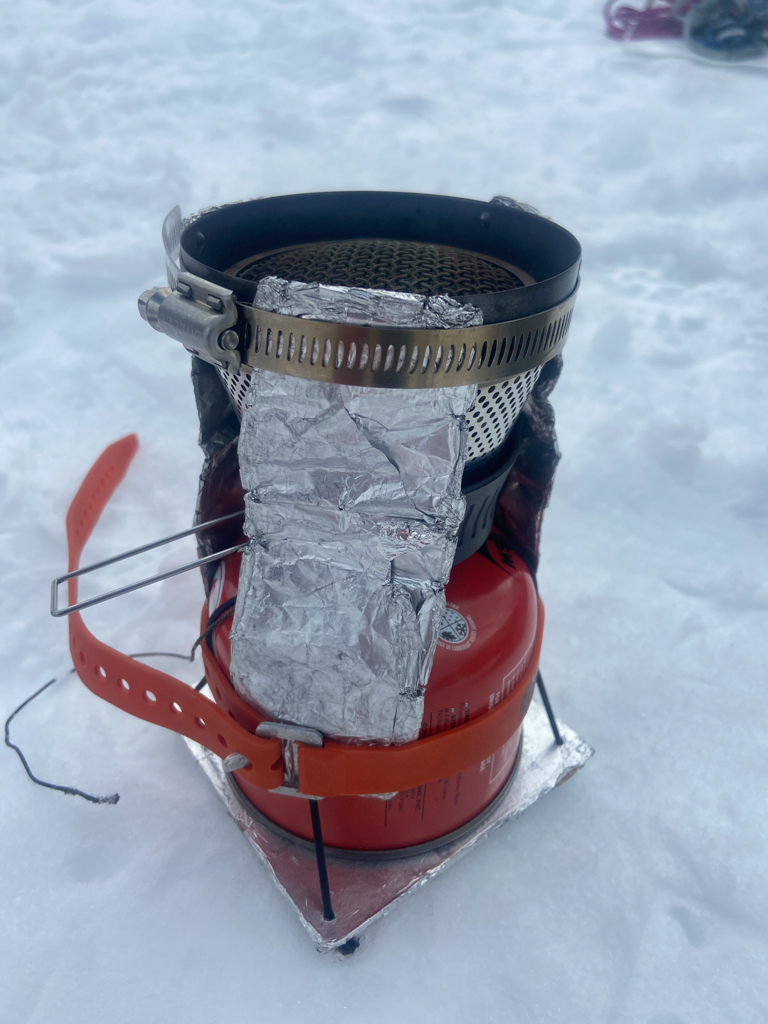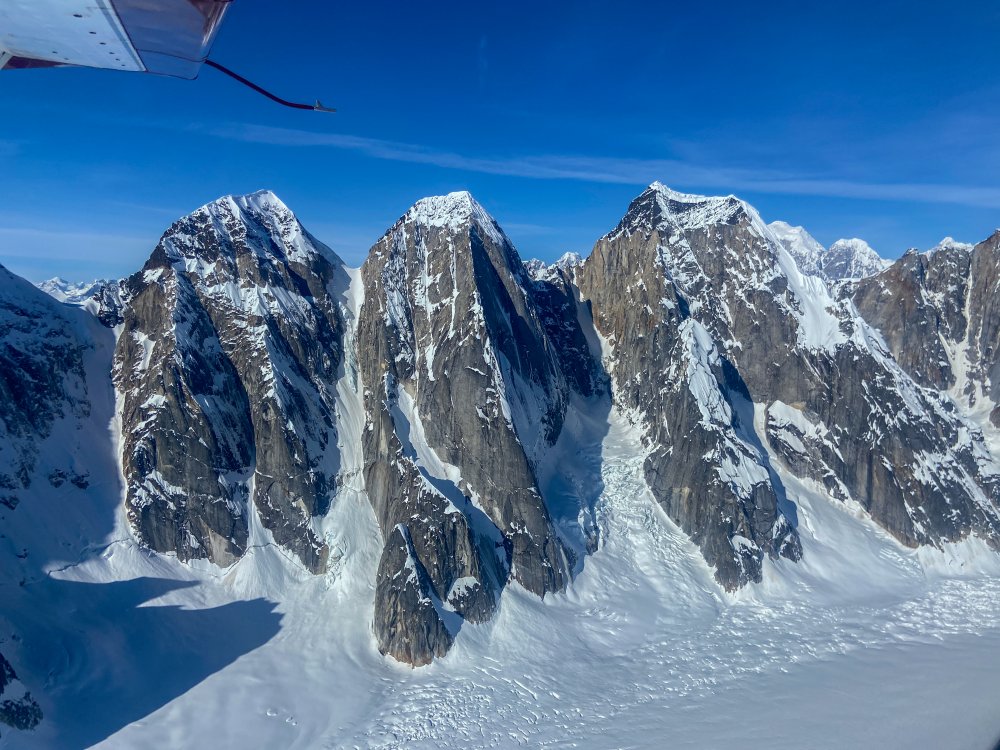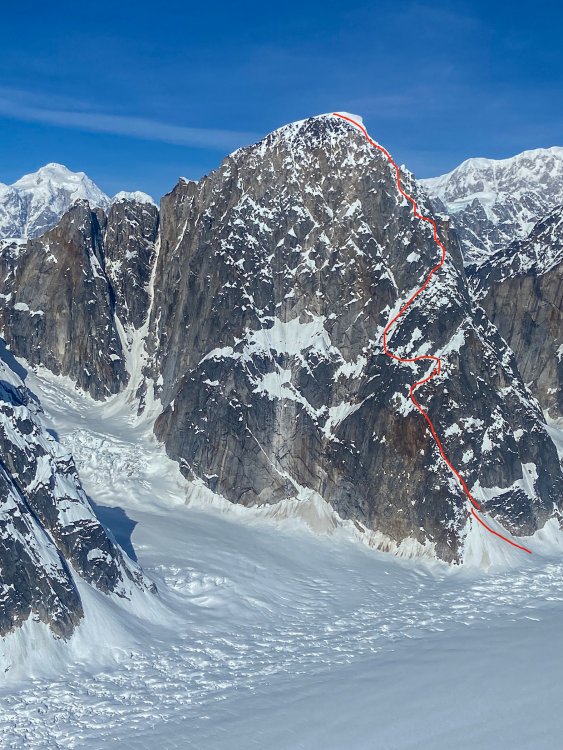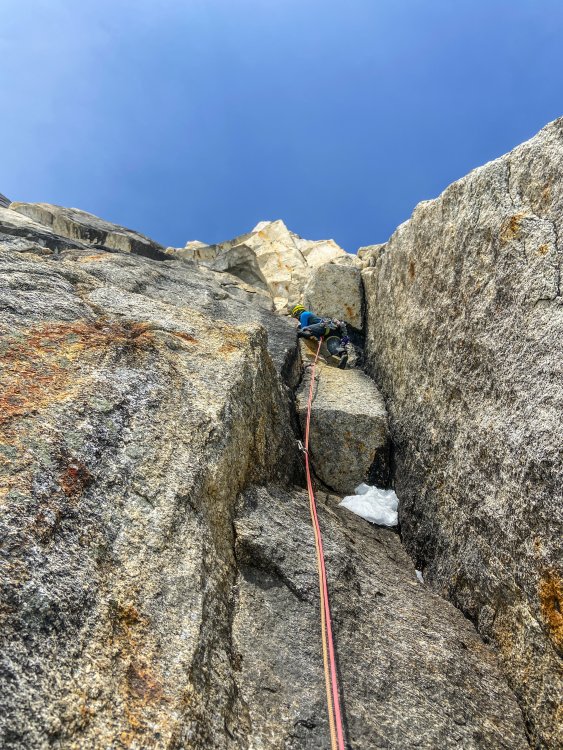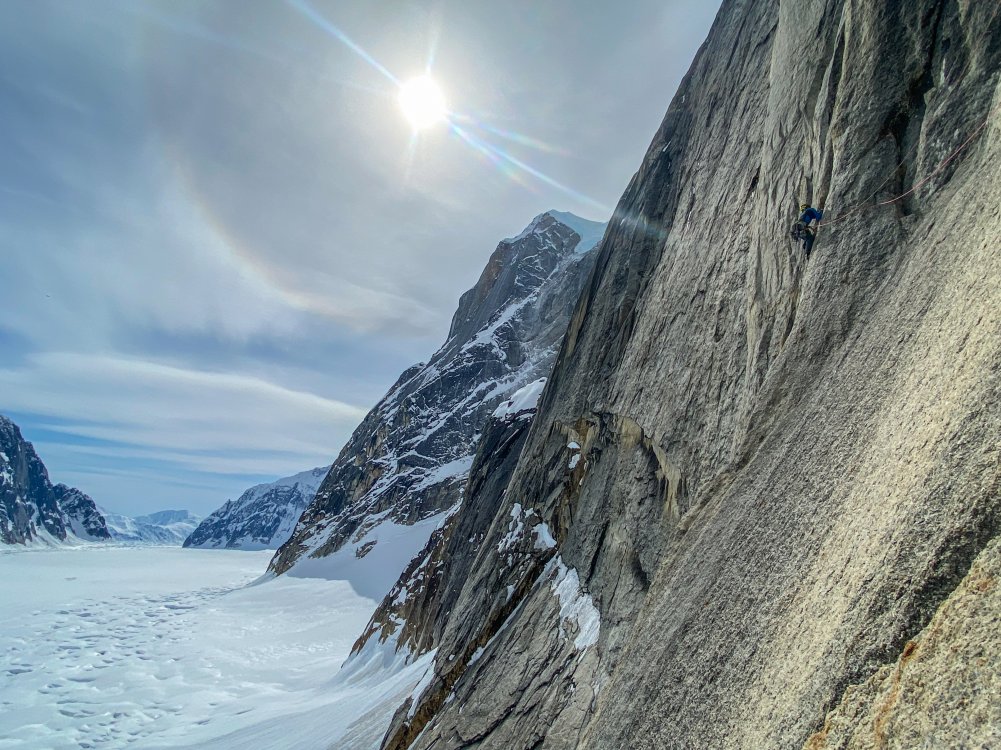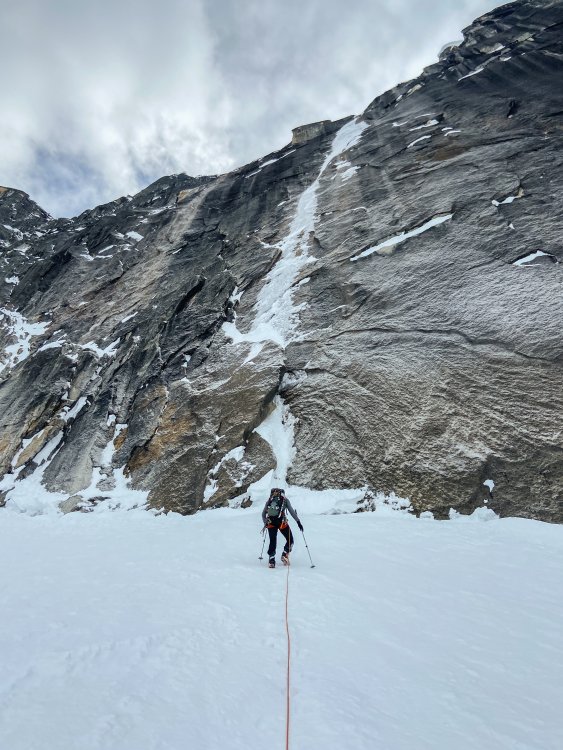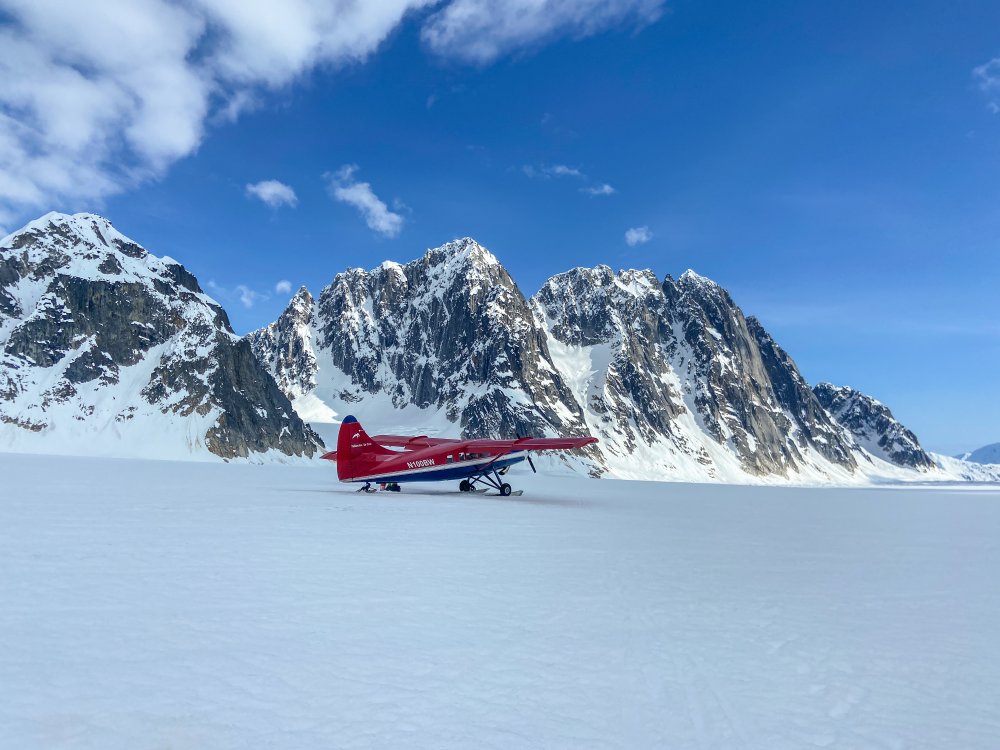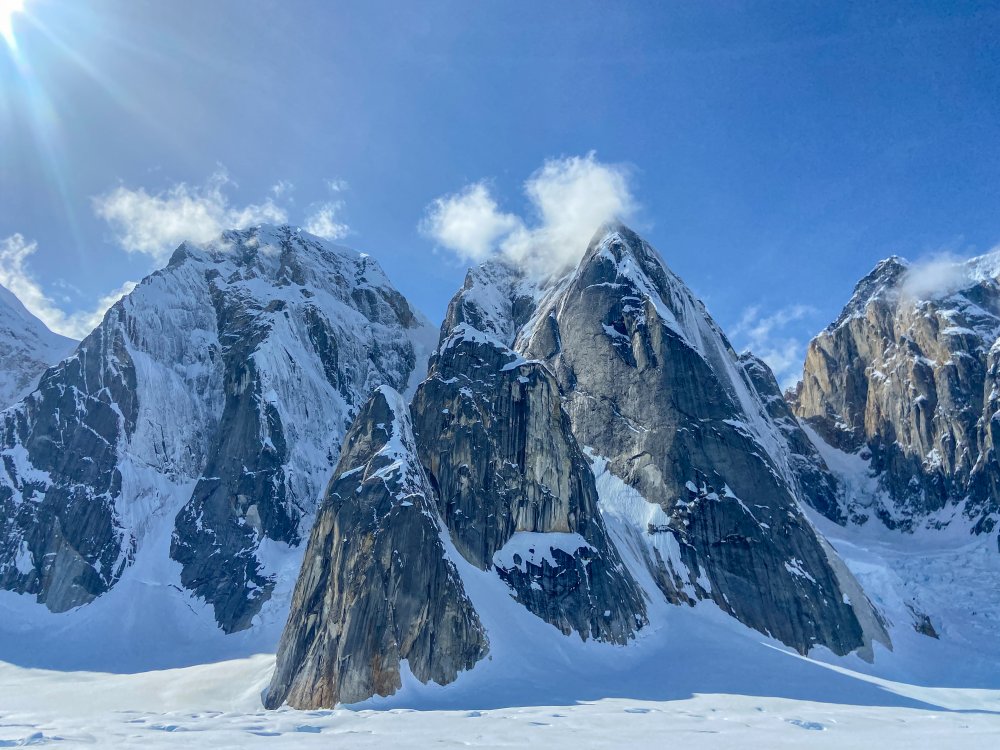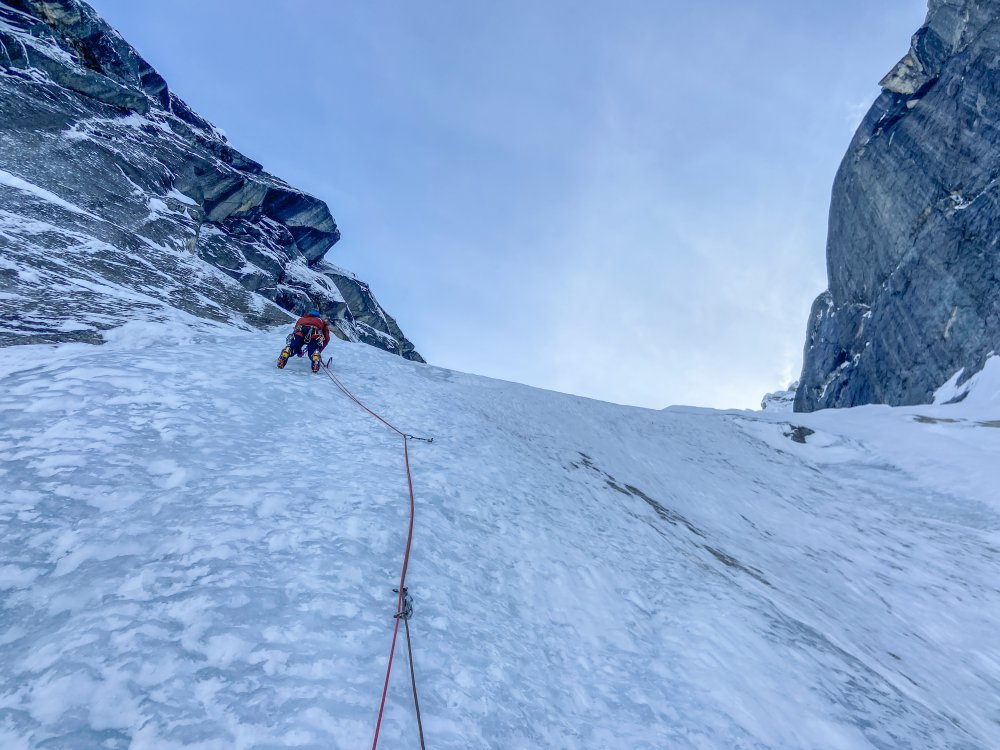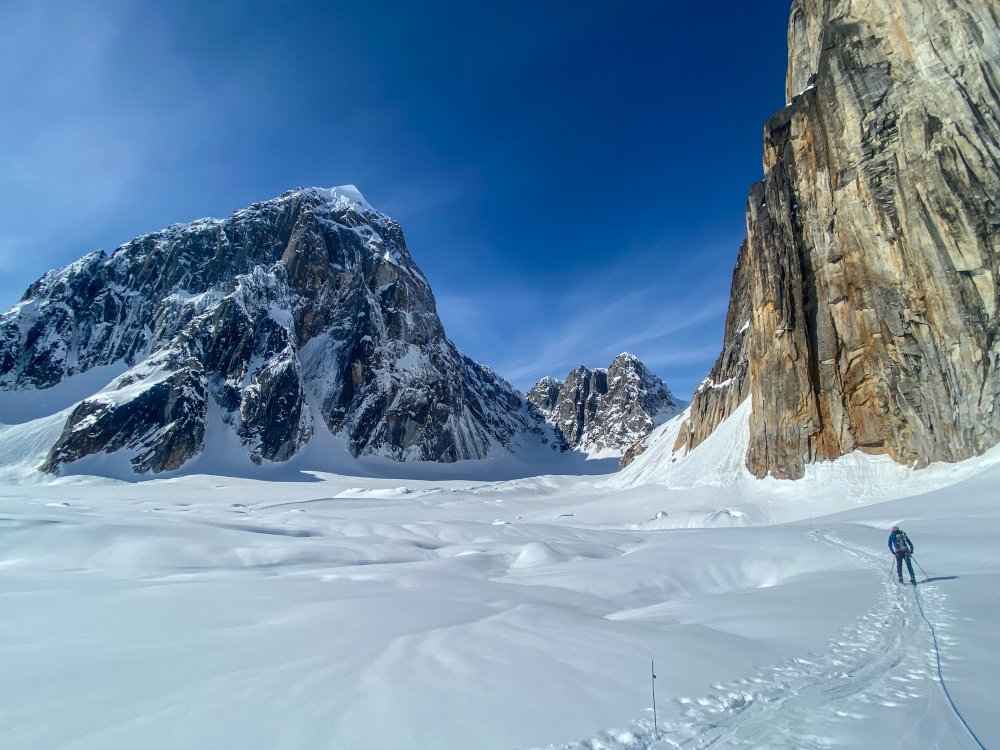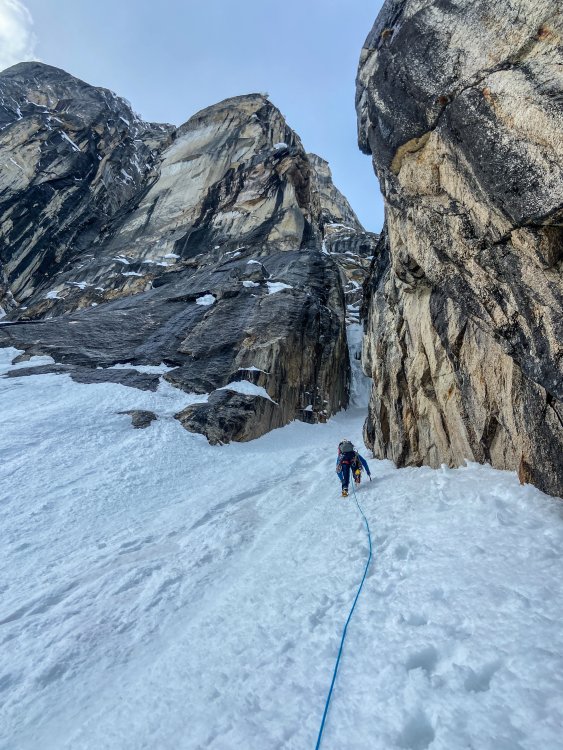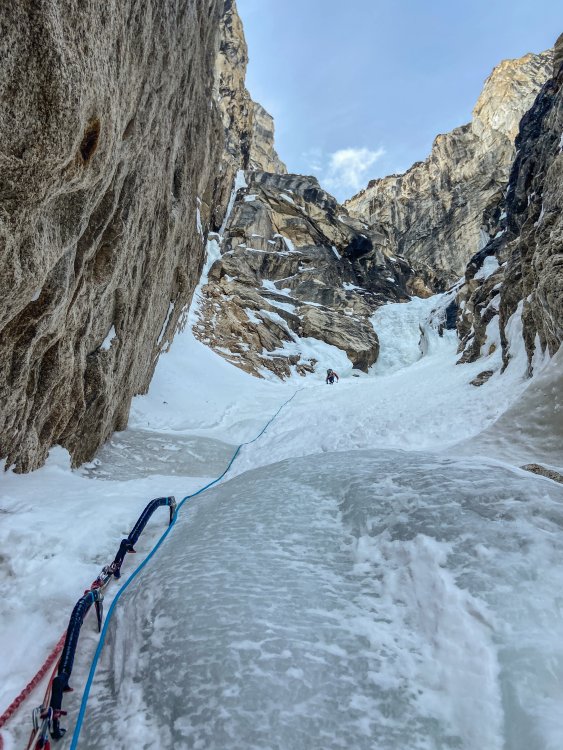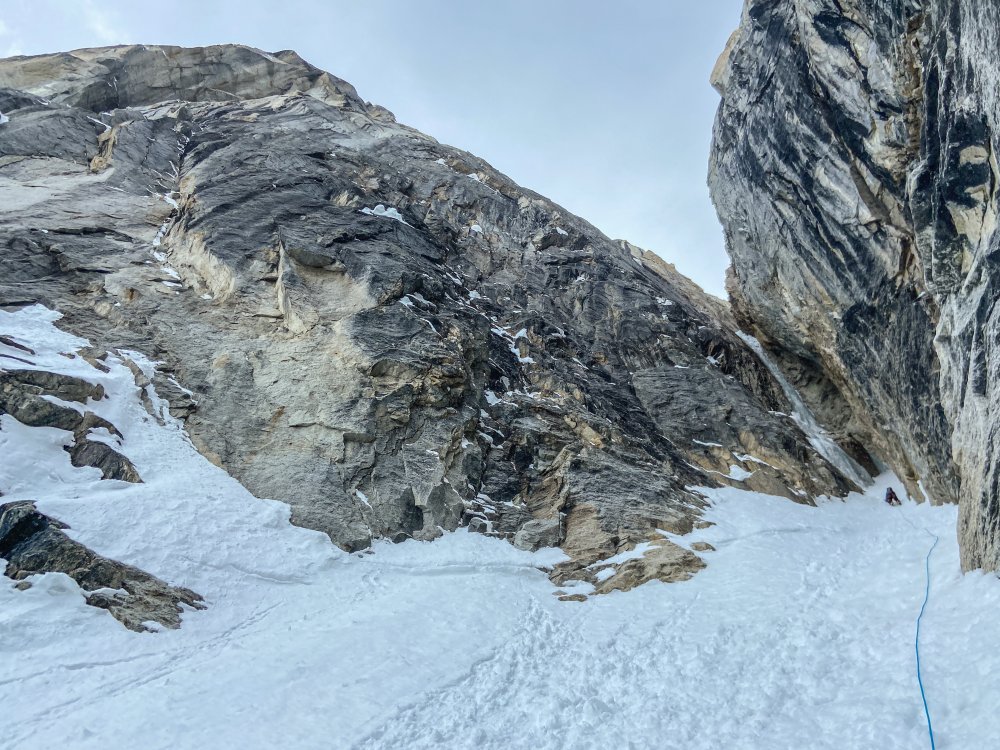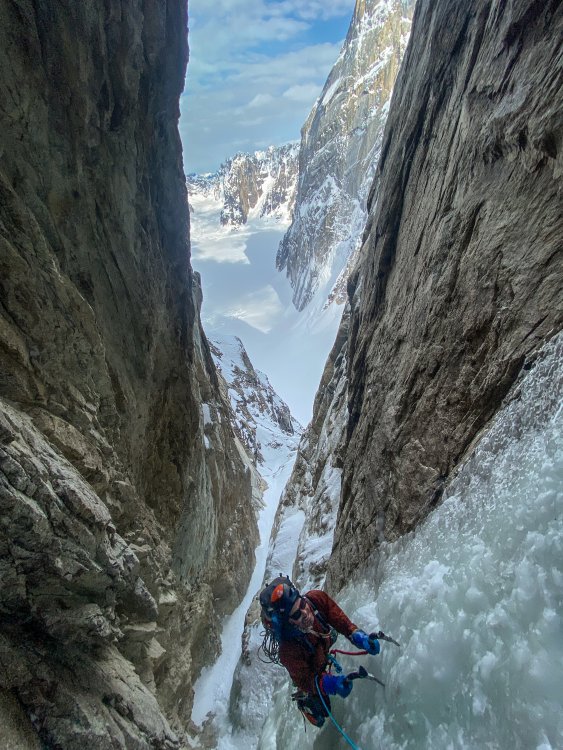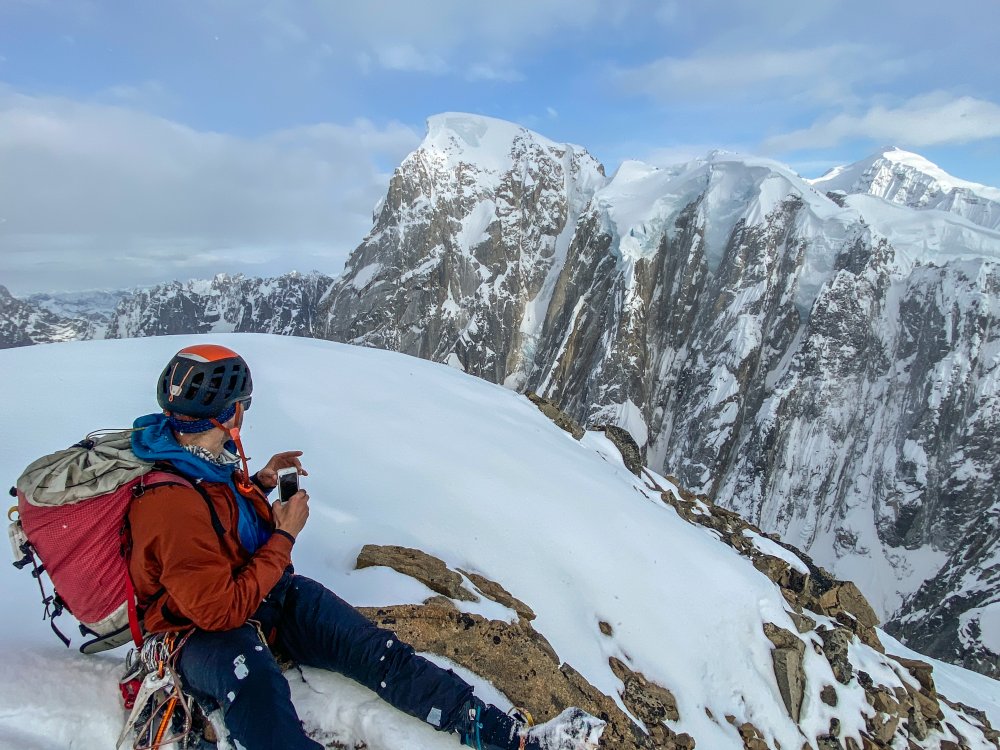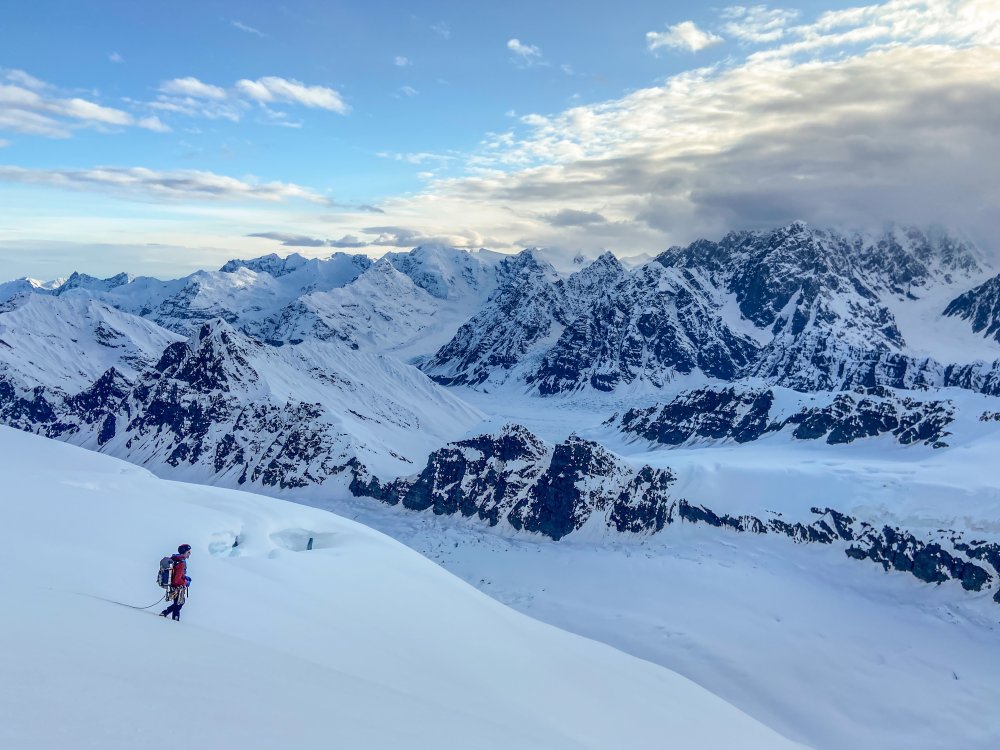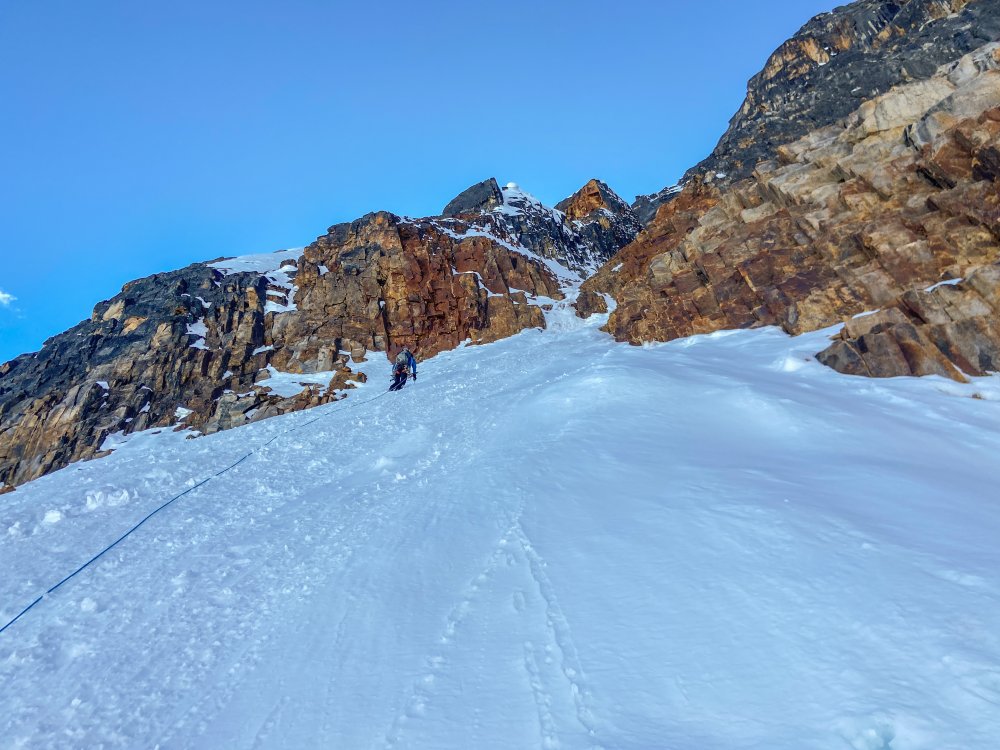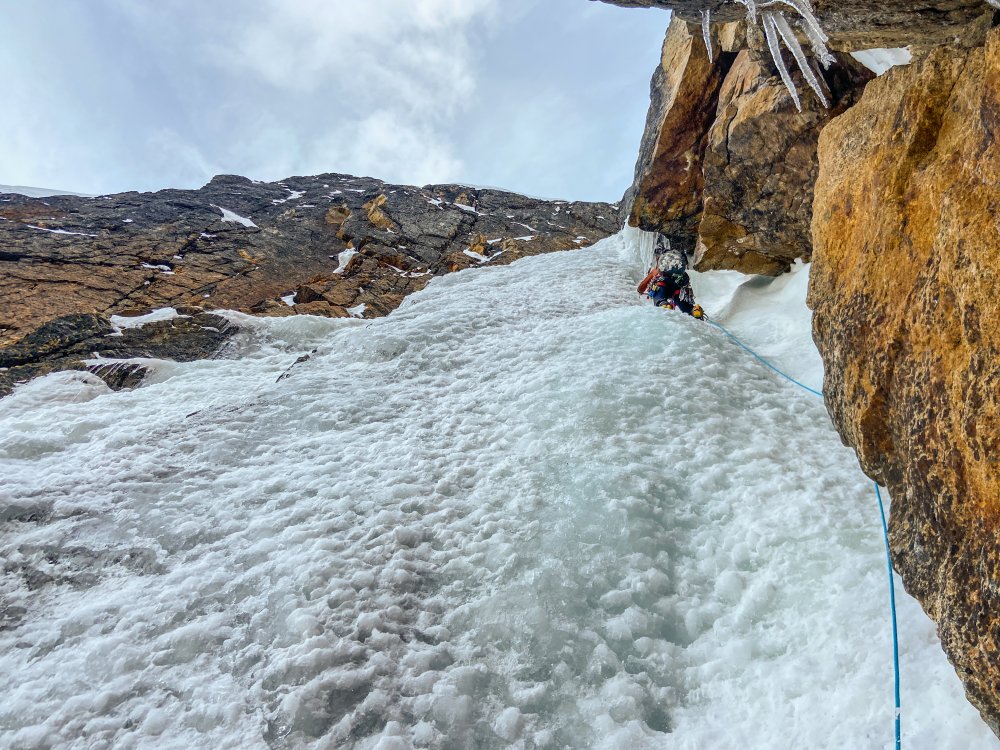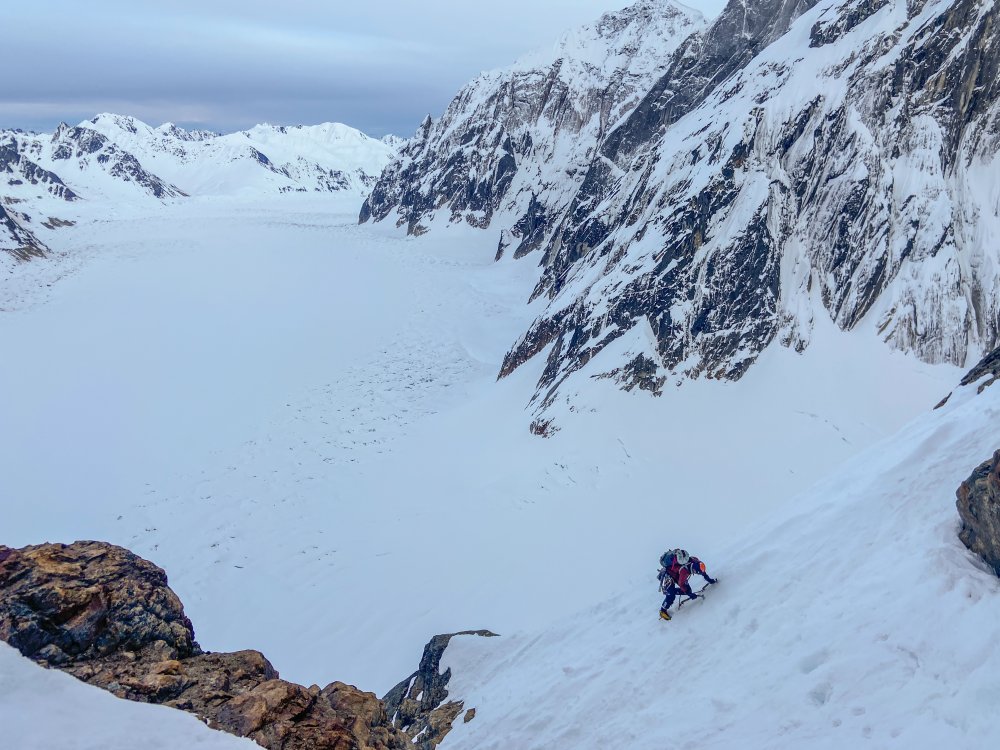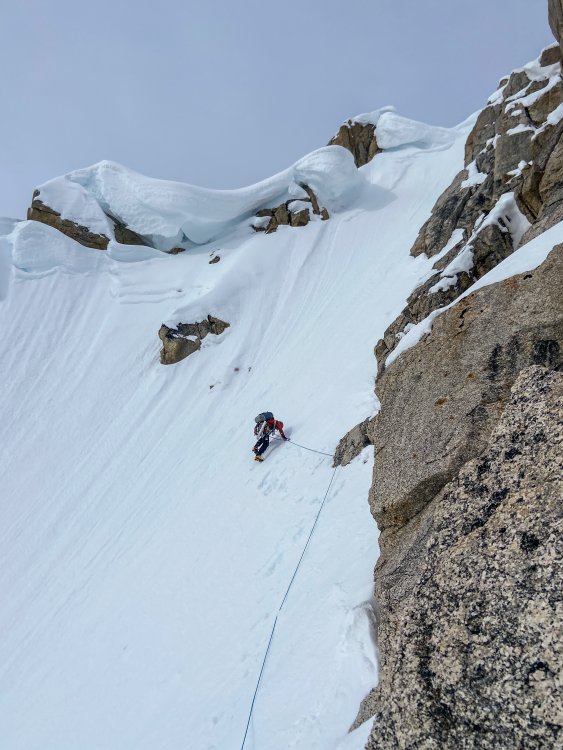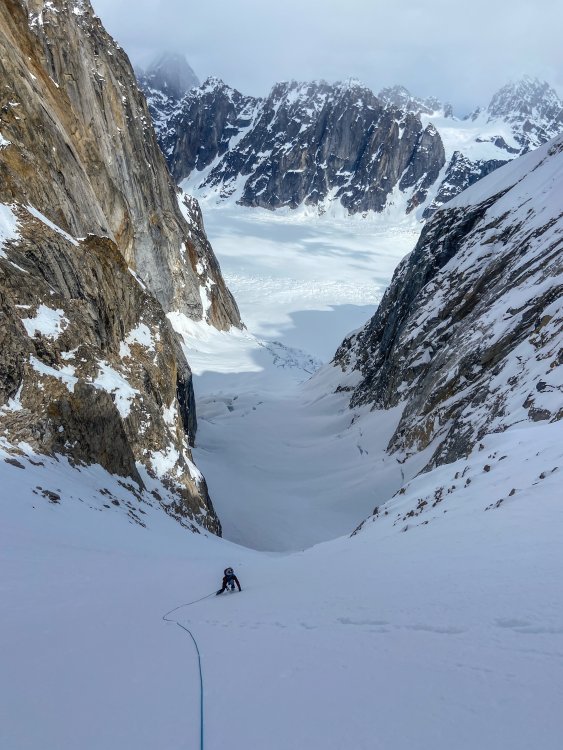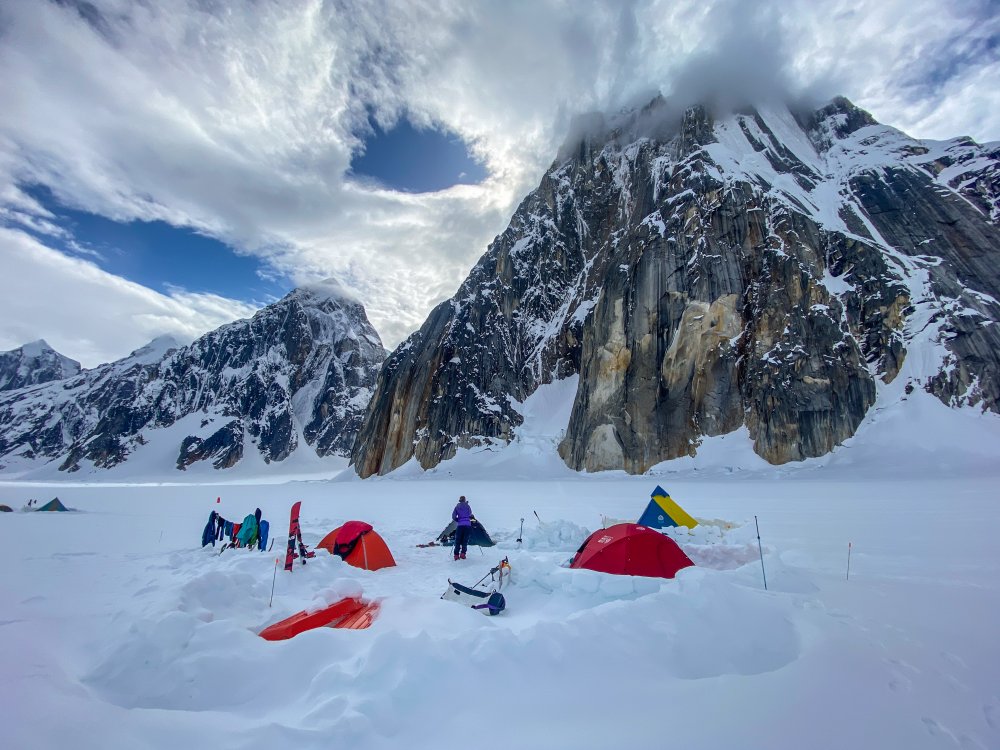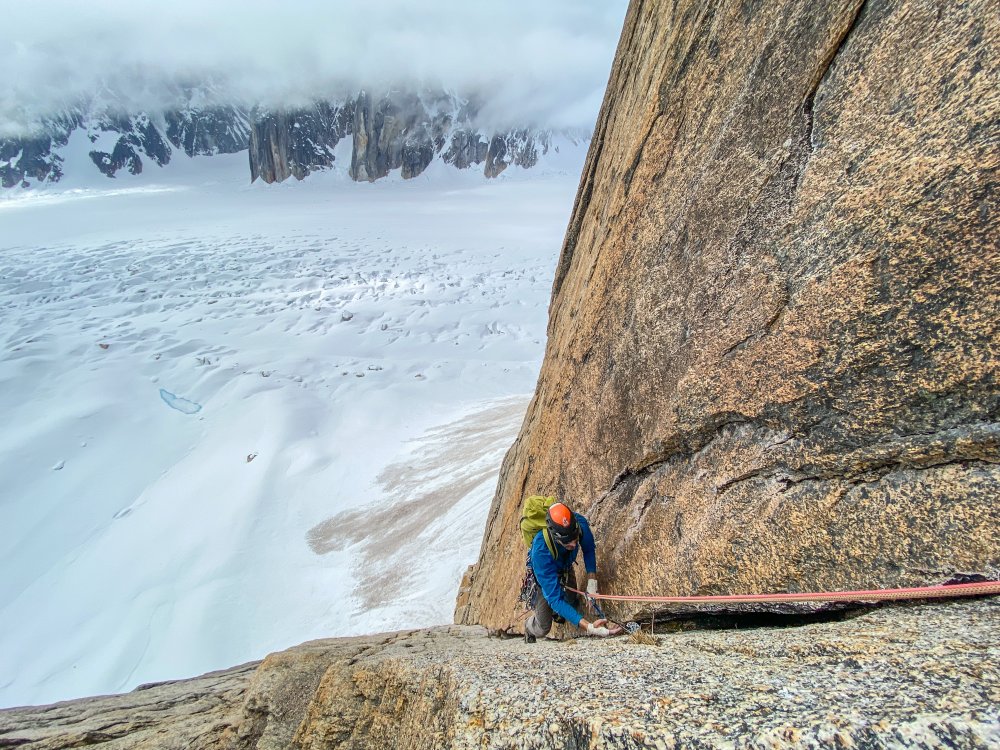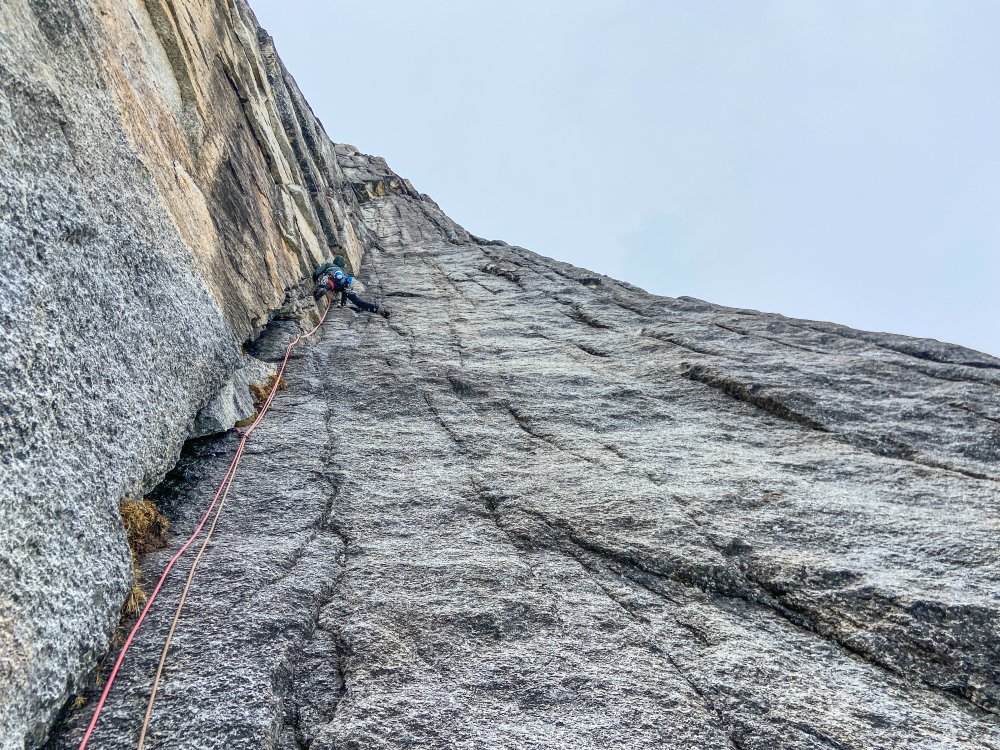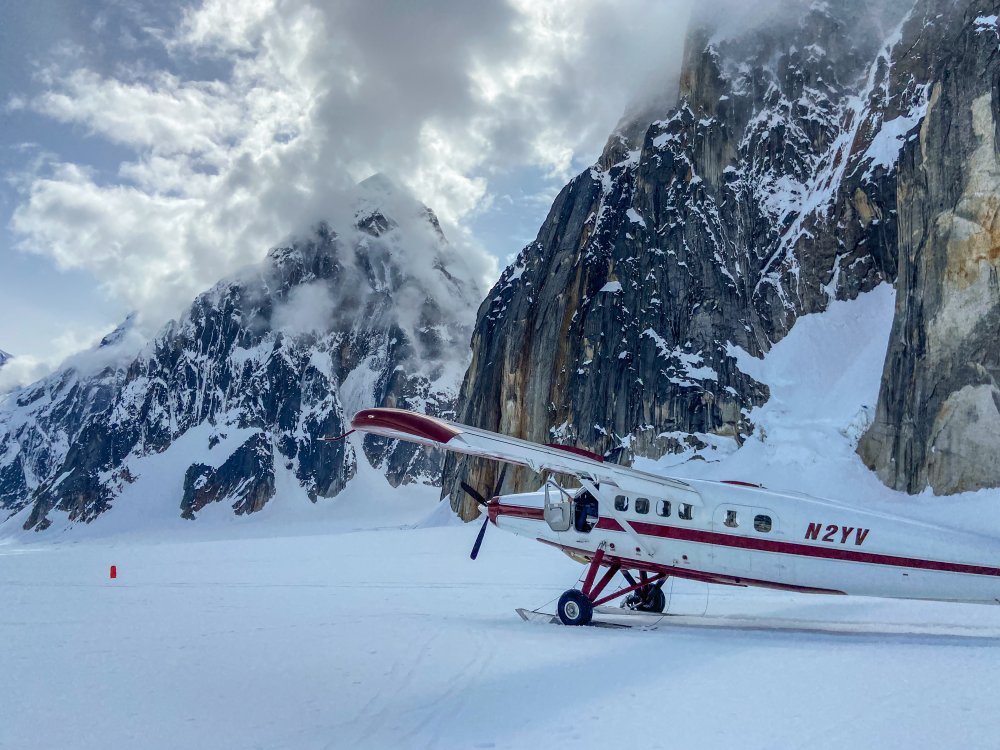
mthorman
Members-
Posts
320 -
Joined
-
Last visited
-
Days Won
27
Everything posted by mthorman
-
Trip: Selkirks - Lionshead - Circle of Life 5.11b/c, C1 FA Trip Date: 08/08/2022 Trip Report: I just finished putting up a project I have been working for the last couple years. It is on the north face of Lionshead up in Selkirk mountains of northern ID. I first heard about the potential line years ago but wasn't climbing hard enough at the time. Then 2 years ago I started investigating and scrubbing it. Finally after many hours of scrubbing it came together this weekend. I do want to thank the numerous friends that I dragged up there who patiently belayed me and also spent hours cleaning and scrubbing the route. The climb is 5 pitches long and contains a lot of really good 5.10 and 5.11 crack climbing. There is 10 feet of pretty blank rock that earns the C1 rating. It is straight forward aiding on a cam and a couple of fixed nuts. For those inclined to try and free it, I would guess it goes at mid to hard 5.12?? So go get the FFA and let me know! The crux pitch would be a classic at most crags complete with really good 5.11 finger crack to some steep laybacking/hands. The descent is to rappel the route which helps make the route feel less committing, and anything in the 5.11 range can be pulled through (although that would be most of pitch 3!). Pitch 1 - 5.9 Pitch 2 - 5.10b Pitch 3 - 5.11b/c, C1 Pitch 4 - 5.10+ Pitch 5 - 5.11b I personally would say it is on par with the classics at WA Pass for quality of climbing although it contains a little more lichen due to lack of traffic currently. I would definitely recommend doing it. The north face of Lionshead in the evening light. The line is marked in red. Starting up pitch 1. Looking up the start of Pitch 2. Starting up the crux Pitch 3. Looking back down the top half of the crux pitch 3. Such good climbing!! Nearing the top of pitch 4. The crux 5.11 roof on pitch 5. Gear Notes: Doubles from .2 to #3 with triples in the .3 to .75 and a single #4. A single set of nuts (offsets more useful than regular). Also a .3/.4 and .4/.5 offset cam come in very handy. 2 ropes for the rappel. Approach Notes: Take the normal approach to Lionshead. The route is on the north face about 100 ft to the right of the route Lion Tamer.
-
[TR] Glacier Peak - Frostbite Ridge 08/07/2022
mthorman replied to jefetronic's topic in North Cascades
Thanks for a great write up and beautiful pictures. I really love that area of the Cascades. Frostbite looks like an interesting route! -
Yea, there is a reason I haven't been super stoked on the pass in recent years. This year I was excited for a trip because I finally felt ready for some of the 5.11s (which I felt were actually pretty good quality). And yes there are lots of other areas with better sustained climbing on good granite. I have spent a fair amount of time in Yosemite wall climbing but I think I need to visit the Sierras for the 5.10 and 5.11 climbing!
-
Most of the 5.9 and under routes in the Liberty Bell Group are either short or not really that interesting of climbing (i.e. 1 good pitch with a bunch of duds). And there are very few 5.10 routes. I would say the East face of Lexington and NW Corner of NEWs are the best at 5.10+ and under. But if you are willing to push into the 5.11 grade there are much better routes with good climbing. Other areas around WA Pass have more options. Clean Break is the best 5.10 route I have done, and I have heard good things of Rampage and Rebel Yell. Also I would look into the stuff over on Big Kagaroo....I have never been over there but have heard from several people that it is very good. I think my next trip will be focused on that stuff!
-
I have used a voile ski strip around the ankles for purposes like this. It isn't the most stylish but it does the job.
-
Trip: A Peak - Knickerbocker and the Bull Moose (FA) Trip Date: 04/25/2022 Trip Report: With a short good weather window and high hopes Earl and I set off into the Cabinets to see what we could find on the North Face of A Peak. We left the trailhead under warm and sunny skies and enjoyed the dirt trail and glacier lily's for the first couple miles. It was definitely spring and we wondered if maybe we were too late in the season already. But about halfway in on the Granite Lake Trail we started hitting snow and by the time we arrived at Granite Lake there had been multiple postholes. Thankfully we arrived an hour before dark so we had time to scope the face of A Peak with binoculars. There was still ice on the Thunderdome and 3 Tiers but it was looking warm and rotting. The north face of A Peak looked good however and we soon decided on our line. The goal was to climb up a main couloir that slices up the face and then follow the corner system above to the summit ridge. After a short night we were hiking out of camp by 3:15am. A couple hours later as the sun rose, we had crampons on and were booting up mostly neve snow in the entrance couloir. The couloir climbing was steep but easy and I was surprised at how good the ice flows were that poured in from the left wall. My partner Earl had climbed these ice features to the snow field above and then connected a line to the summit ridge 3 weeks ago as a solo first ascent (Bull River Prowler, M4, AI3, 600m). At the top of the couloir the real climbing began. We followed the corner system above mostly containing mixed rock with a few patches of ice in the corners. The gear was generally good but the climbing slow and tedious cleaning snow off the rock or testing holds for loose rock. On the 3rd pitch Earl was cleaning some loose rocks when the snow mushroom he was standing on collapsed. He was suddenly left dangling from one hand on a great steinpull. Somehow he kept his composure and reestablished his feet on the rock before taking the fall. After 4 pitches of engaging climbing we reached a saddle in the buttress that had been on our right. From here the obvious line continued another 4 pitches up the corner systems above. These pitches were all easier in difficulty and had more ice. The 6th pitch was probably the most aesthetic if only because it started on a thin ice traverse that allowed for some great pictures. By this point on the face we had an incredible view of the basin below and even across the ridges towards the town of Libby. The last pitch ended with a chimney, then a "birth canal" squeeze to some cornice digging to reach the summit ridge. All in all it was a proper adventure. We were 12hrs climbing the 8 pitches and 18hrs camp to camp. The decent was pretty straightforward because we could see. We hiked the ridge to the south towards Snowshoe Peak until we found a steep slope between cliff bands to descend back down into the basin to the east. From there it was a couple miles and several thousand feet of postholing down the basin and back around to Granite Lake. We called our line Knickerbocker and the Bull Moose in reference to both the Wool Knickers that Earl wore on the ascent as well as the moose that continually likes to post hole and destroy our trail into granite lake. It was an awesome experience to be able to put up such an amazing line on A peak. The climbing is quite good and in my opinion on par with many of the classic climbs I have done in the Ruth Gorge of AK (in terms of difficulty and quality). Knickerbocker and the Bull Moose, IV, M5, AI4, 600m. Looking up at A Peak from Granite Lake in the fading light. Roughly the route we took. Passing by the route that Earl had put up 3 weeks before called Bull River Prowler. Our route continued up the couloir and then the corner system above. Looking down the couloir from the top as we rack up for the mixed pitches. Earl starting up pitch 1. Looking up the top half of pitch 2 which turned out to be the crux. Looking down from the top of Pitch 2. Earl starting up Pitch 3. Earl starting up pitch 5 where the climbing got easier. Enjoying some thin ice on the beautiful Pitch 6. Me looking up Pitch 7 before starting out. The upper half of the route was mostly this terrain...fun moderate mixed climbing. Looking up the beginning of pitch 8 with the cornice looming overhead. Earl and I on the summit ridge while on the decent with the true summit directly behind us. Gear Notes: We had double set of cams from .4 to #2 with single #3, 8-10 pins (heavy on the LAs and KBs), set of offset nuts, set of tri-cams(doubles in the 2 smallest sizes) and 5 screws (all short). We placed a lot of pins and the tri-cams came in very useful as well. In addition we wished we had a couple more small cams below .4. Approach Notes: Hike the Granite Lake Trail to Granite Lake in the Cabinet Mountains. From the lake hike up 2000ft to the base of the North Face.
-
We did discuss going in there, but never really got to the final stages of planning. If I remember right the 2 options that seemed reasonable to us was just hike your stuff in or pay to have a gear drop by horseback. I never got far enough along the process to look at back side decent options. Sorry....not much help!
-
Trout Creek is closed right now for Eagle nesting. It may open in May or it might in August.....depends on where the Eagles nest.
-
Those are the climbs in Moses Coulee. The 1st and 4th pics are of a climb called Butch Cassidy. But I have NEVER seen that top pitch forming as a skinny pillar....crazy!! The 3rd pic is Sundance Kid. And the 2nd pic is of an unnamed route that has only formed a couple times that I am aware of. Jens Holsten and Shaun Johnson climbed it in January of 2017.
-
I just wanted to say that despite 2022 being a thin year overall there is still great climbing to be had at Granite Lake. And there have been multiple groups over the last couple weeks in there so people are getting after it! We climbed Mad Max (WI4) and Road Warrior (WI5, M5) in back to back days last week. The original crux pitch of Mad Max (WI5+) still hasn't ever come back in but the corner adjacent to the face pitch is in every year. This still climbs the line but keeps the grade at a moderate WI4. This route is probably the best long WI4 route I have done (7 pitches). Road Warrior was pretty challenging as the crux mixed pitch didn't have enough ice to protect or swing into but just enough verglass to make drytooling VERY hard. Be prepared for some awkward chimney/offwidth moves with tools and crampons! Or just climb Blackwell Falls (WI5, 4 pitches) and keep it on the ice! Adrien starting up Road Warrior (Blackwell Falls is the name for just climbing the ice). The ice over on the right is the Mad Max Line. Adrien starting up the crux M5 pitch of Road Warrior with the chimney looming above. Adrien leading pitch 5 of Mad Max a super cool thin ice WI4 pitch.
-
[TR] Forbidden Peak Winter Ascent - West Ridge 01/23/2022
mthorman replied to Eric Gilbertson's topic in North Cascades
Heck yea guys!! Looks like a beautiful day up high!! -
I decided to create a map of Banks Lake ice climbs to help fellow climbers out. It is through Cal Topo and has all the routes marked from where you can see them on the road. With the exception of a couple that you need to hike up to see (those are marked where the climb is). All the mileposts are marked as references. You should be able to turn those off on the left hand side if they get annoying. Also I added a link to a picture of the route. So if you click on any of the routes you have to copy/paste the link and it should take you to the picture. Basically it can kind of serve as a guide to help people figure out what they are looking at. Anyway let me know what you guys think. I would be happy to try and add or change things as people see mistakes or have good ideas. https://caltopo.com/m/G61HV
-
Drove along Banks Lake today. Overall it still needs a lot of time. I was really surprised at how little ice was there. From South to North. Absent Minded Professors - no ice at all The Cable - maybe halfway but overall skinny/thin. H2O2 - Looked good. Agent Orange - no ice Salt and Pepper - no ice at all More Banks ice - some ice...just hangers Climbs just north of "More Banks Ice" - 2 routes look in. 3 more are trying Climbs south of Brush Hell/Brush Bash - 3 routes look in 4 more trying Brush Hell - Looks to be in Brush Bash - Trying Shitting Razorblades - no ice at all The Emerald - unknown, but based on the fact that the smaller climb right off the road below Emerald was dry....I doubt it. Climb below Emerald - no ice at all Unknown climbs - 2 lines at MP 14 which is one pullout south of Zenith. Both were in and climbed well (about 3+/4 and 5.) Zenith - it is touching but very thin on the bottom 50 feet (ie not enough for screws) Peewees - 1 (in), 2 (trying), 3 (very close probably climbable just harder than the normal grade), 4 (in), 5 (in) 6 (trying) 7 (in) and 8 (trying) Devils Punchbowl - Fat with some very nasty daggers above Trotsky's Revenge/Phase Transition - Looked good (again with nasty daggers above) Trotsky's Folly - In Kilowatt - trying to form (some ice up high) Megawatt - no ice at all Gigawatt - no ice at all Across the lake.... Bombs over Bagdad - No ice Tea in the Sahara - No ice Something new across the lake from MP 9.5 ish - the top half is in and you could walk around the bottom half to get to it. Something new across the lake from MP 11 - skinny pillar is just about touching. I have been asked regarding the location of some of these. So I created a Caltopo map. It has all the above climbs (almost all are marked where you park on the road). And it has all the Mileposts for reference. Hopefully this helps some people out. https://caltopo.com/m/G61HV
- 28 replies
-
- 2
-

-

-
- ice climbing
- pnw
-
(and 1 more)
Tagged with:
-
Thanks for checking out Banks. I have been watching the weather reports pretty closely and figured it would be starting to form up. Given the current extended forecast I think things will be looking pretty good come New Years. The pictures you posted are of Zenith and the Devils Punchbowl area.
- 28 replies
-
- ice climbing
- pnw
-
(and 1 more)
Tagged with:
-
Banks needs snow on the ground to provide water so unless they get a couple inches of snow then cold weather there won't be much ice. Typically it needs a couple weeks of good cold weather as well so I think we are still a while out from anything good out there.
- 28 replies
-
- ice climbing
- pnw
-
(and 1 more)
Tagged with:
-
[TR] El Dorado - NW Couloir (Attempt) 11/21/2021
mthorman replied to Grant789's topic in North Cascades
A very clever friend of mine rigged up this to conduct heat from the stove down to the fuel canister. It worked great for us up in Alaska and I will be building my own version patterned after this. But in a pinch you can use some hot water from your stove in the plastic cup. It also helps to keep your fuel warm...meaning sleep with it or at least keep it insulated and out of the snow. -
Sold
- 1 reply
-
- glacier glasses
- glacier
-
(and 3 more)
Tagged with:
-
$120 (shipped). New with tags - Julbo Glacier Glasses, Explorer 2.0. Color: Dark blue with Polarized REACTIV Cameleon High Mountain 2-4 lenses (photochromatic, adjust to light, 5%-20% visible light transmission). Side lens shades removable. They were too big for my wife and unable to return.
- 1 reply
-
- glacier glasses
- glacier
-
(and 3 more)
Tagged with:
-
Yea we climbed Free Friends last week and approached from the Priest Lake side. Once you get to the saddle just before going up to Roothaan you can take a trail around the north side of the mountain that stays high and crosses to the east side of the crest just north of Roothaan. From there it is a pleasant walk along the east side of the crest to the East Face of Chimney Rock. Approach is only a little over an hour this way! Oh and the route is really good quality.
-
Trip: Ruth Gorge - Kuriositeten and Mount Bradley plus others Trip Date: 04/26/2021 Trip Report: I am a little late in posting this because I had a 3 week Denali expedition right after this trip. So I am just now getting back into the swing of regular life and unpacking. Anyway I figured I would post up a trip report from the Ruth Gorge. We flew in on April 26 to the Ruth Glacier just below the East Face of Dickey. Man that is a face to dream about!! We were a team of 4 that functioned as 2 teams of 2. We just changed up partners a few times based on people’s route choice. The Ruth Gorge was Plan B and we didn’t know we were going to the Ruth until about 4 days prior to flying in. So we were pretty ill prepared with route research and overall beta (with the exception of the classic lines). Grosvenor, Johnson, and Wake (left to right), from the flight in. Talkeetna Air Taxi on the Ruth Glacier with Peak 7400 and London Towers in the background. April 27 - Our first full day on the glacier. It was warm and sunny and I teamed up with Robbie to head for Cobra Pillar and just see how the climbing was. We got up to the top of pitch 5 when the sun disappeared behind the mountain and it started to get cold. We were also less than impressed by the first 5 pitches. When the guidebook says “C1+ rotten or 5.11” you should probably just avoid that pitch! I led it and was literally kicking new footholds into the large granite crystals and hoping they wouldn’t crumble under my bodyweight. Needless to say we had no desire to go back with so much other good looking rock. Robbie on the 2nd pitch of Cobra Pillar. Robbie just after the traverse on Cobra Pillar April 28 - We scoped several lines and tried to generally figure out what lines had been done. Thankfully we had used our phone to screen shot several AAJ articles so we were able to figure out some of it. Our efforts were mostly focused on Dickey and Peak 7400 since they were the closest to camp. Scoping a potential ice line. April 29-30 - weather days. Snowed about 18 inches. May 1 - We scoped lines going south on the Ruth Glacier. Looked at stuff on Bradley, Wake, Johnson, and London Towers. We were starting to get a good sense of snow conditions based on aspect and finally figuring out where everything is. We did climb the opening 2 pitches of The Escalator on Mt Johnson. It was really fun alpine ice and it gave us a good excuse to use the ice tools and screws. There were a couple of steeper smears to the left that we hoped to climb but the ice was only about 2-3 inches thick and there wasn’t any rock pro available. Scoping "The Escalator" on Mount Johnson. Climbing up the first couple ice pitches on The Escalator on Mount Johnson. Great alpine ice! May 2 - Based on the conditions we found yesterday we deemed it prudent to give the mountains one more day to shed snow and get some freeze/thaw going so it wouldn’t be a postholing nightmare. We had brought a telescope so we looked very closely at a couple of lines that interested us and talked about what line to do tomorrow. A couple people of our group went over to check out the first couple pitches of “The Wine Bottle” on Mt. Dickey. Man that is an inspiring looking line! We watched them through the telescope. May 3 - I teamed up with Duncan to climb Kuriositeten (AI5, M3+, 800m). It is a “smaller route” that was first put up in 2008 on peak just left of 747 Pass. At 2500ft it isn’t really a small route but when you see how it looks sitting between the giants of Dickey and Bradley it appears small. The route follows a couloir splitting the east face of the peak. It is a lot of snow climbing but also contains some mixed steps and 3 distinct ice steps ranging from 15m to 70m tall. Honestly it reminded me of some of the climbing in Cody, WY, where you follow a twisting canyon/couloir always excited about what might be around the next corner. The crux is the final step. It is about 70m+ and the first half is pretty dead vertical. Thankfully the ice quality was great and we throughly enjoyed the position deap inside the slot. We had very little beta about this route so had only brought 7 screws. We were able to find rock gear for the beginning belay and then I just ran it out as far as I dared between screws. We still had to break it into 2 pitches as I found myself with only 2 anchor screws left after 35m. Duncan took the upper half and soon we found ourselves on the snow slopes above. This is a fantastic route in the Ruth and should see more traffic! One of the reasons we wanted to climb this route was to recon the decent from Bradley. One of the reports we had regarding Bradley, was to descend the “standard west ridge” but that party bailed down a face after not being able to descend the west ridge. Another report talked about descending to the Backside Glacier and walking way back around through 747 pass. Another report talked about descending the Bradley/Wake Col. To complicate matters CalTopo and Gaia both showed some weird topography anomalies on their topo maps. In fact both showed a 800-1000ft cliff coming off the back side of Bradley that looked very complicated to navigate around. The problem was the topo lines didn’t seem to match what we had heard in reports. Needless to say we were very interested in looking at the descent from the top of Kuriositeten. In the end we discovered that both Gaia and CalTopo were very wrong in their topography. In places it was off by 1000ft. What appeared to be a huge cliff was just a small snow slope that was easily walkable. We couldn’t see the whole decent but we felt much better about things after this day. Skiing over to Kuriositeten. It climbs the big gash on the peak in the middle back. Even though the line is 2500ft tall it looks small in comparison to Bradley (left) and Dickey (right). Duncan starting up Kuriositeten. Looking up from the belay at the top of the first ice step. Approaching the 3rd ice step crux. It is the narrow looking ribbon of ice way up in the slot. Duncan climbing up through the crux pitch on Kuriositeten. A fantastic route in the Ruth. From the summit of Kuriositeten looking over towards Mount Bradley. Descending the back side of Kuriositeten in the late evening light. May 4 - Rest day. May 5 and 6 - For the big goal of the trip we picked Mount Bradley. A couple of our party had started up the East Ridge of Bradley the day I had climbed on Cobra Pillar. They found deep unconsolidated snow on all northern aspects. Even though it is called the East Ridge the first 1/3 of the route is mostly on the north side of the ridge. So with no desire to go up that unconsolidated snow we searched for a new route. While looking through all of our screenshots from the AAJ we found John Frieh’s report about a linkup on Mt. Bradley. He and Dylan Johnson had also found bad snow on the start of the regular East Buttress. So with high hopes we set our eyes on their Link of “Season of the Sun" and the “East Buttress”. They rated it M5/6 and the route is 4500 feet tall. It was warm so our plan was to leave camp in the late afternoon and start the route in the evening. We were hoping that by this time the snow might start freezing back up from the day and we could avoid some nasty postholing by climbing through the night. We left camp at 4pm and but 5:15pm we were in crampons working our way up the initial snow slopes. The Season of the Sun route climbs on the right side of the SE face of the mountain and was originally put up by the Giri-Giri Boys. We were a little concerned about the reported M6 offwidth crux but figured we would take it one step at a time. After about 1000 ft of snow with short steps of rock and ice we arrived at the “crux”. We were pleasantly to find it full of ice (AI3). So after a quick romp up great ice and another pitch of low angle rock we arrived at the 2nd couloir. From here route goes up right then back left across snow slopes and around the end of a big buttress. This leads you into the big central gully about mid height on the face. The original Seasons of the Sun route cuts up and back left to stay on the face while we followed Frieh/Johnson’s variation back towards the East Buttress proper. It was somewhere in here that it got dark. Not pitch black but dark enough to warrant a headlamp when technical climbing. Several mixed pitches in the dark brought us to the East Buttress proper. From here another 2 long fun mixed pitches deposited us underneath a huge boulder. By this time it was getting light again and we were out of water. So we spent an hour brewing up and resting. The rest of the east buttress went by in a blur of simul-climbing including one section where I ran out of carabiners and slings and literally clipped the carabiner with all my nuts to a piton just so I could clip the rope in. We topped out on the summit about 10am. The decent was pretty straight forward although with more uphill than we liked. We just followed the main ridge to the west and then cut down and south to follow a different ridge line back towards the Bradley/Wake Col. Unfortunately this led us to wallow up several northern aspects of unconsolidated powder snow. Nothing like trenching in the afternoon sun when you have been up all night! We finally reached the col and took a short break to drink the last of our water and finish up our food. Then it was 2000ft of easy walking down to the last obstacle…the icefall between Wake and Bradley. From the top of the col it appeared to be less broken up on skiers left. But when we arrived skiers left there was only sagging “snow bridges” and open crevasses. We were able to end run everything far left and then rappel over the last bergshrund by leaving a bomber fixed nut in the rock. Finally home free we trudged wearily back towards the base of the route. The snow was like a trap door. Most steps you were fine but every few steps the door would open and suddenly you would be postholing to your thigh. We were excited to be back to our skis were the going suddenly got easy! Rolled back into camp at 7:30pm for a 27.5hr RT time. Starting up Seasons of the Sun. The M6 offwidth crux....we got lucky with fat ice conditions and easy climbing. Typically route conditions...soloing steep snow. About 1/4 of the way up the route now. Nearing the top of the East Buttress proper......during one of the long simul-blocks. The route up Bradley's 4500ft face. This is a linkup of Seasons of the Sun and the East Buttress first done by John Frieh and Dylan Johnson. Descending back down from the Bradley/Wake Col after climbing Mt. Bradley. May 7 - Weather day. Snowed off and on all day. May 8 - Snowed a bit then cleared up in the afternoon but wasn’t enough time for much more than a casual ski. It was warm again. We watched several ice lines we had been looking at fall off the walls. Our camp below the east face of Mount Dickey. Mount Bradley is just to the left of center in behind. May 9 - With the warm weather we opted for rock climbing. But the sun didn’t burn the clouds off until noon so we got a late start. We decided on Goldfinger which is on the Stump. We started climbing and were happy to find good quality rock. The rock quality was WAY better than the first few pitches of Cobra Pillar. Unfortunately due to our late start we lost the sun and our warmth about the top of pitch 6. We contemplated going a few more pitches but opted to just call it since it was unlikely we would top out anyway with such a late start. The climbing was very good though and it would be a classic anywhere in the lower 48. Coming up to the belay at the top of Pitch 2 of Goldfinger. Climbing pitch 6 of Goldfinger. It is fantastic climbing on very good quality rock! May 10 - With bad weather in the forecast for the next several days we opted to fly out. Several of the team members had flights out of Anchorage on the 13th so we didn’t want to be stuck on the glacier and miss flights. TAT here to pick us up. The ever changing clouds giving Mt. Bradley a moody look as we departed. Gear Notes: Alpine rack, heavy on screws for ice routes, heavy on cams for rock routes. Approach Notes: Fly in with Talkeetna Air Taxi, then ski/hike to climbs.
- 4 replies
-
- 11
-

-

-
My ice pitches look like the following right now. Note this is only pitches I have led. Do to the nature of leading vs. TR on ice I didn't count or factor in TR laps in my pyramid. The one thing I did use the TR pitches for was gauging when to start leading. I spent an entire year just doing TR laps and got about 60 pitches in before I really stepped up to start leading. I value that year as a good skills year of learning to read ice! WI3 - 81 pitches WI4 - 66 pitches WI5 - 34 pitches WI6 - 6 pitches My numbers show myself that I have enough of a base to where I should be able to focus and lead a bunch more WI5 and WI6 when I am feeling strong. Although I will say that unlike rock, ice seems to have so many more factors to consider (temps, ice condition, how cold I am etc). I have gotten to the point where it is more about how I am feeling that day and how things look from the bottom than the grades. I use the grades as more of a reference (ie do I want a hard day out or a chill day out?) especially since picked out WI5 will feel easier than many a fresh WI4. Last note on the pitch counts, I think I was roughly around 20 pitches at a particular grade before I started moving to the next grade much. I didn't hold that as a fast and hard rule more like a....don't try to lead a bunch of pitches of the next grade until you have built up good experience at the past grade. Mixed climbing is such a different beast to me. Maybe it is because I have only mixed climbed at the drytool crag in Spokane. Well I have done a few other pitches of where the route got a mixed grade but it was mostly in the alpine where grading can be difficult anyway because it depends so much on conditions. I guess if I climbed a bunch of mixed grades at Hyalite or up in Canada maybe I would have a better idea of the grading and could help compare things. But in my limited experience it is either brutally hard drytooling (stout M6 or M7) in Spokane or easy mixed climbing on an alpine climb like M3/M4 (think West Ridge of Stuart in Winter for example). Where are you getting in your mixed climbing?
-
Hmm thanks for that...it is interesting. You sparked my curiosity so I had to go look. I have 1052 routes from 5.9-5.11. That doesn't include any multipitch climbs either since I keep those on a separate Excell spreadsheet and was too lazy to go through and figure out how many pitches of 5.9-5.11 there are. I have always been an onsite climber and it is rare for me to try the same route a couple times before sending. But I have also never lead a 5.12 clean so maybe it is time to start redpointing and/or hangboarding! I have roughly 350 trad pitches and 700 sport pitches.....which I am not sure is relevant to the discussion but interesting to note. I can't believe there are 800 routes at Smith in that range. That is a lot more than I would have guessed. I should also just sit down and read his book....I think I have it buried on a shelf somewhere. I do pay attention to my ice pitches a lot more. I want to make sure I have a good base for a pyramid so I keep pretty good tabs of lead climbing on ice. I don't move up to leading the next grade much until I have a good base at the previous grade. I know that seems common sense but it serves as a good visual reminder for me to be patient. Ice is not a place to get in over your head!


